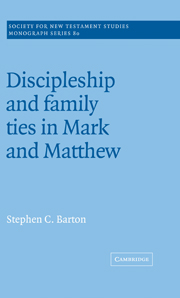Book contents
3 - Discipleship and family ties in Mark
Published online by Cambridge University Press: 15 October 2009
Summary
Introduction
One of the best ways of describing the ethos and self-understanding of a religious community or movement is to analyse its attitudes to natural ties. Such ties may be economic, geographical, racial or familial; and they are the means by which a group identifies itself and sustains itself. For a religious movement, discourse about natural ties – and especially family ties – frequently constitutes a major idiom of commitment and community. For example, attitudes to the family may function as a test of allegiance to the charismatic leader. The subordination of the family may be part of the cost of adherence. The religious community may come to represent itself in familial terms, as a kind of alternative family or brotherhood, whose role norms and authority patterns are modelled to some extent on those of the natural family. These, in general terms, are the kinds of observations made by sociological observers of sects and new religious movements.
The aim of this chapter is to discuss the ethos and self-understanding of the Marcan community by means of an analysis of family- and household-related material in the Gospel of Mark. In undertaking this analysis, I am working on the assumption which undergirds all history-of-traditions and redaction-critical work on the gospels, that the history of the tradition bears witness to the history of the community which preserves it and passes it on.
- Type
- Chapter
- Information
- Discipleship and Family Ties in Mark and Matthew , pp. 57 - 124Publisher: Cambridge University PressPrint publication year: 1994

